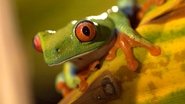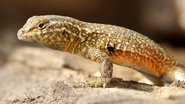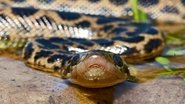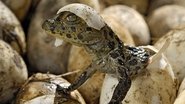-

-
-
Life in Cold Blood : Season 1
-
Air date: 04 Feb '08 - 5 episodesDavid Attenborough reveals the surprising truth about the cold-blooded lives of reptiles and amphibians. These animals are as dramatic, as colourful and as tender as any other animals.
-
-
List of Episodes (5)
-
Life in Cold Blood (2008)

-
1. The Cold Blooded Truth
04 Feb '08The first episode discusses the keys to success of reptiles and amphibians, looking at thermoregulation, parental care and the time-scales on which reptiles operate. Attenborough begins in the Galápagos Islands, using thermal imaging to demonstrate how marine iguanas warm their bodies by basking in the sun before feeding. Meanwhile, the lizard inhabitants of a Minorcan island have a relationship with its indigenous dead horse arum plants. Attenborough visits Dassen Island to witness one of the
-
Life in Cold Blood (2008)

-
2. Land Invaders
11 Feb '08The second programme explores the world of amphibians, of which there are some 6,000 known species. Attenborough visits Australia to illustrate how they became the first back-boned creatures to colonise land: the lungfish, which is capable of breathing air, and whose ancestors became the first amphibians. The largest of them is the Japanese giant salamander and two are shown wrestling for territory. In North America, the marbled salamander spends most of its life on land, yet is still able to
-
Life in Cold Blood (2008)

-
3. Dragons of the Dry
18 Feb '08The third instalment takes a look at the immense diversity, social skills and displays of the lizards. While they are highly adept at camouflage, occasionally there is a need to break cover in order to ward off rivals. Attenborough holds up a mirror to an anole and causes it to extend its colourful throat flap as a warning sign. Madagascar is host to over 60 species of chameleon but one of the largest, Meller's chameleon, is native to Malawi and two rival males are shown jousting. A female South
-
Life in Cold Blood (2008)

-
4. Sophisticated Serpents
25 Feb '08The fourth episode focuses on the most modern reptiles, the snakes, exploring how they have managed to become successful despite their elongated body shape. Attenborough explains how they evolved from underground burrowers to surface hunters, losing their limbs in the process. With the aid of infrared cameras, a timber rattlesnake is shown lying in wait for a mouse and sensing its repeated path before despatching and eating it. A snake's constantly flickering tongue is used to gather and
-
Life in Cold Blood (2008)

-
5. Armoured Giants
03 Mar '08The final programme covers the most ancient of the reptiles: the crocodiles and turtles. In the Galápagos Islands, among the giant tortoises, Attenborough explains how the creatures came to develop their shells as a defence against predators. This is demonstrated by the eastern box turtle, whose shell includes a hinged 'drawbridge'. The aquatic pig-nosed turtle is unusual in that its eggs need to be submerged before hatching, whereas those of other species would drown; Attenborough illustrates
-












